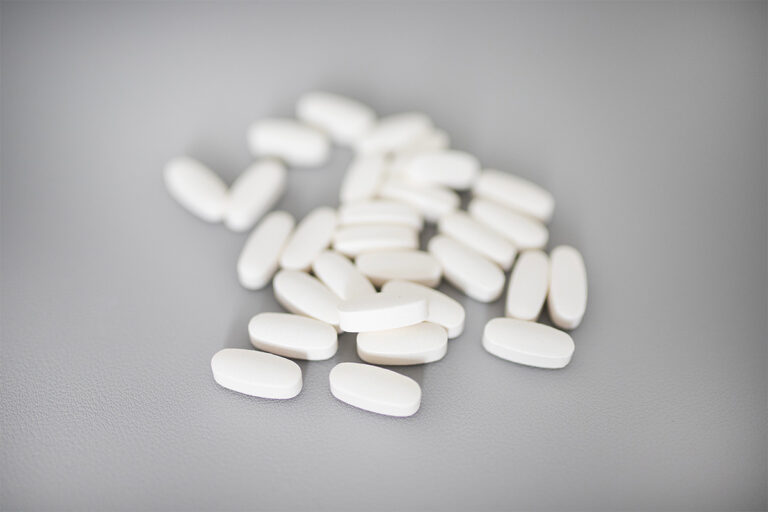What is palmitoylethanolamide (PEA)?
Palmitoylethanolamide (PEA) is a naturally occurring, endocannabinoid-like compound best known for its chronic pain-relieving and anti-inflammatory properties. (2)(14) In addition to being synthesized by the body, PEA is also found in various foods, including:- Cheese
- Egg yolk
- Meat
- Milk
- Peanuts
- Soy lecithin (10)
PEA and the endocannabinoid system
The endocannabinoid system (ECS) is a cell signaling network responsible for regulating numerous physiological and cognitive processes and maintaining homeostasis in response to internal and external stressors. (3) PEA has been shown to support the ECS through several mechanisms. (2) Endocannabinoids and endocannabinoid-like compounds like PEA can help to relieve chronic pain and inflammation in the body by binding to selective receptors found on the surface of neurons (nerve cells) and immune cells and activate signaling pathways. (11) Learn more about the endocannabinoid system on the Fullscript blog.Did you know? Research demonstrates that PEA binds to a receptor in the cell nucleus known as the peroxisome proliferator–activated receptor, which regulates gene networks that control pain and inflammation. (8)
Palmitoylethanolamide benefits
Due to it’s analgesic and anti-inflammatory effects, research suggests that PEA may be useful in addressing various pain-related conditions, such as fibromyalgia, sciatic pain, and osteoarthritis. (6)(9)(18)1. Fibromyalgia
Several studies demonstrate that PEA may help reduce symptoms of fibromyalgia, a chronic neurological condition that causes widespread pain. When used as an adjunct to traditional therapies, PEA intake decreased pain intensity over time and improved quality of life. (16) According to one study, PEA administration for three months significantly reduced pain in individuals with fibromyalgia. (6)2. Back pain
Preliminary research points to the potential efficacy of PEA for back pain. A 2017 observational study demonstrated that PEA, when used in addition to two pain-relieving prescription medications, tapentadol and pregabalin, further decreased pain intensity in individuals suffering from failed back surgery syndrome. (13) Individuals with sciatic pain, a type of pain that extends down one or both legs from the lower back, may also find relief when taking PEA. A randomized double-blind, placebo-controlled trial investigated the effects of high and low dose PEA versus placebo. The high dose group experienced more than a 50% reduction in pain. Although the low dose of PEA did not exert the same degree of pain relief as the high dose, both doses were significantly more effective than placebo. (9)3. Osteoarthritis
PEA may be beneficial for individuals with osteoarthritis, a condition characterized by degeneration of joint cartilage and bone. Participants in one study who were given PEA experienced significant improvements in Western Ontario and McMaster Universities Osteoarthritis Index (WOMAC) scores compared to the placebo group. WOMAC is a questionnaire that is used to evaluate the condition and symptoms (e.g., pain, stiffness, physical functioning) of those with osteoarthritis of the knee and hip. (18) Another study involving individuals with temporomandibular joint inflammatory (TMJ) pain related to osteoarthritis noted significant improvements in pain intensity after 14 days of PEA supplementation compared with ibuprofen. The group given PEA for 14 days experienced improvements in maximum mouth opening, an indicator of pain relief, significantly greater than those in the ibuprofen group. (12)4. Neuropathic pain
Preliminary case studies and animal trials suggest that PEA may be useful for addressing neuropathic pain (caused by damage to the nerves that transfer information between the brain and spinal cord), particularly for individuals with carpal tunnel syndrome, diabetic neuropathy, chemotherapy-induced peripheral neuropathy, chronic pelvic pain, and pain associated with stroke and multiple sclerosis. (8) Further clinical trials are needed to determine the efficacy of PEA for addressing neuropathic pain.
PEA supplementation may improve pain related to osteoarthritis. (18)
Safety of PEA supplementation
Short-term use of PEA is widely recognized as safe, and most people using PEA report no drug-drug interactions or side effects. However, limited data exists on the long-term effects of PEA. (7) If you’re a patient, as with any dietary supplement, it’s best to consult an integrative healthcare practitioner before introducing a new supplement into your regimen.Did you know? PEA has poor solubility, absorption, and bioavailability; therefore, PEA supplements feature advanced delivery systems such as liposomes, nano-emulsions, and solid lipid particles. (4)
The bottom line
Palmitoylethanolamide (PEA) is an endocannabinoid-like compound that is synthesized by the body and found in certain foods, such as egg yolk, meat, dairy, peanuts, and soy lecithin. Research demonstrates that PEA has analgesic and anti-inflammatory properties, making it potentially beneficial for patients suffering from chronic pain. Although PEA is regarded for its pain-relieving properties, emerging research suggests other potential clinical applications, such as irritable bowel syndrome, (5) sleep disturbances, (15) autism spectrum disorders (ASDs), and more. (1)- Antonucci, N., Cirillo, A., & Siniscalco, D. (2015). Beneficial effects of palmitoylethanolamide on expressive language, cognition, and behaviors in autism: A report of two cases. Case Reports in Psychiatry, 2015, 1–6.
- Clayton, P., Hill, M., Bogoda, N., Subah, S., & Venkatesh, R. (2021). Palmitoylethanolamide: A natural compound for health management. International Journal of Molecular Sciences, 22(10), 5305.
- Clayton, P., Subah, S., Venkatesh, R., Hill, M., & Bogoda, N. (2021). Palmitoylethanolamide: A potential alternative to cannabidiol. Journal of Dietary Supplements, 1–26.
- Conte, R., Marturano, V., Peluso, G., Calarco, A., & Cerruti, P. (2017). Recent advances in Nanoparticle-Mediated delivery of Anti-Inflammatory phytocompounds. International Journal of Molecular Sciences, 18(4), 709.
- Cremon, C., Stanghellini, V., Barbaro, M. R., Cogliandro, R. F., Bellacosa, L., Santos, J., Et al. (2017). Randomised clinical trial: The analgesic properties of dietary supplementation with palmitoylethanolamide and polydatin in irritable bowel syndrome. Alimentary Pharmacology & Therapeutics, 45(7), 909–922.
- del Giorno, R., Skaper, S., Paladini, A., Varrassi, G., & Coaccioli, S. (2015). Palmitoylethanolamide in fibromyalgia: Results from prospective and retrospective observational studies. Pain and Therapy, 4(2), 169–178.
- Gabrielsson, L., Mattsson, S., & Fowler, C. J. (2016). Palmitoylethanolamide for the treatment of pain: Pharmacokinetics, safety and efficacy. British Journal of Clinical Pharmacology, 82(4), 932–942.
- Keppel Hesselink, J., & Hekker. (2012). Therapeutic utility of palmitoylethanolamide in the treatment of neuropathic pain associated with various pathological conditions: A case series. Journal of Pain Research, 437.
- Keppel Hesselink, J., & Kopsky, D. (2015). Palmitoylethanolamide, a neutraceutical, in nerve compression syndromes: Efficacy and safety in sciatic pain and carpal tunnel syndrome. Journal of Pain Research, 729.
- Keppel Hesselink, J. M., de Boer, T., & Witkamp, R. F. (2013). Palmitoylethanolamide: A natural Body-Own Anti-Inflammatory agent, effective and safe against influenza and common cold. International Journal of Inflammation, 2013, 1–8.
- lo Verme, J., Fu, J., Astarita, G., La Rana, G., Russo, R., Calignano, A., & Piomelli, D. (2004). The nuclear receptor peroxisome Proliferator-Activated receptor-α mediates the Anti-Inflammatory actions of palmitoylethanolamide. Molecular Pharmacology, 67(1), 15–19.
- Marini, I., Bartolucci, M. L., Bortolotti, F., Gatto, M. R., & Bonetti, G. A. (2012). Palmitoylethanolamide versus a nonsteroidal anti-inflammatory drug in the treatment of temporomandibular joint inflammatory pain. J Orofac Pain, 26(2), 99–104.
- Paladini, A., Varrassi, G., Bentivegna, G., Carletti, S., Piroli, A., & Coaccioli, S. (2017). Palmitoylethanolamide in the treatment of failed back surgery syndrome. Pain Research and Treatment, 2017, 1–6.
- Petrosino, S., & di Marzo, V. (2016). The pharmacology of palmitoylethanolamide and first data on the therapeutic efficacy of some of its new formulations. British Journal of Pharmacology, 174(11), 1349–1365.
- Rao, A., Ebelt, P., Mallard, A., & Briskey, D. (2021). Palmitoylethanolamide for sleep disturbance. A double-blind, randomised, placebo-controlled interventional study. Sleep Science and Practice, 5(1), 12.
- Schweiger, V., Martini, A., Bellamoli, P., Donadello, K., Schievano, C., Balzo, G. D., Sarzi-Puttini, P., Parolini, M., & Polati, E. (2019). Ultramicronized palmitoylethanolamide (um-PEA) as add-on treatment in fibromyalgia syndrome (FMS): Retrospective observational study on 407 patients. CNS & Neurological Disorders – Drug Targets, 18(4), 326–333.
- Skaper, S. D., & Facci, L. (2012). Mast cell–glia axis in neuroinflammation and therapeutic potential of the anandamide congener palmitoylethanolamide. Philosophical Transactions of the Royal Society B: Biological Sciences, 367(1607), 3312–3325.
- Steels, E., Venkatesh, R., Steels, E., Vitetta, G., & Vitetta, L. (2019). A double-blind randomized placebo controlled study assessing safety, tolerability and efficacy of palmitoylethanolamide for symptoms of knee osteoarthritis. Inflammopharmacology, 27(3), 475–485.






